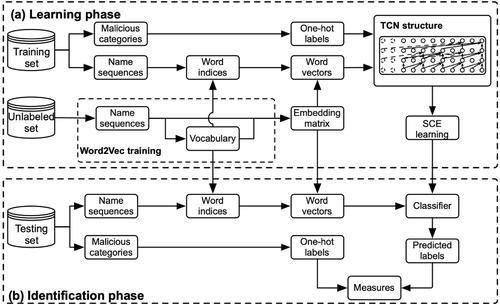当前位置:
X-MOL 学术
›
IET Softw.
›
论文详情
Our official English website, www.x-mol.net, welcomes your feedback! (Note: you will need to create a separate account there.)
Robust Malware identification via deep temporal convolutional network with symmetric cross entropy learning
IET Software ( IF 1.6 ) Pub Date : 2023-07-07 , DOI: 10.1049/sfw2.12137 Jiankun Sun 1, 2, 3 , Xiong Luo 1, 2, 3 , Weiping Wang 1, 2, 3 , Yang Gao 4 , Wenbing Zhao 5
IET Software ( IF 1.6 ) Pub Date : 2023-07-07 , DOI: 10.1049/sfw2.12137 Jiankun Sun 1, 2, 3 , Xiong Luo 1, 2, 3 , Weiping Wang 1, 2, 3 , Yang Gao 4 , Wenbing Zhao 5
Affiliation

|
Recent developments in the field of Internet of things (IoT) have aroused growing attention to the security of smart devices. Specifically, there is an increasing number of malicious software (Malware) on IoT systems. Nowadays, researchers have made many efforts concerning supervised machine learning methods to identify malicious attacks. High-quality labels are of great importance for supervised machine learning, but noises widely exist due to the non-deterministic production environment. Therefore, learning from noisy labels is significant for machine learning-enabled Malware identification. In this study, motivated by the symmetric cross entropy with satisfactory noise robustness, the authors propose a robust Malware identification method using temporal convolutional network (TCN). Moreover, word embedding techniques are generally utilised to understand the contextual relationship between the input operation code (opcode) and application programming interface function names. Here, considering the numerous unlabelled samples in real-world intelligent environments, the authors pre-train the TCN model on an unlabelled set using a word embedding method, that is, Word2Vec. In the experiments, the proposed method is compared with several traditional statistical methods and more recent neural networks on a synthetic Malware dataset and a real-world dataset. The performance comparisons demonstrate the better performance and noise robustness of their proposed method, especially that the proposed method can yield the best identification accuracy of 98.75% in real-world scenarios.
中文翻译:

通过具有对称交叉熵学习的深度时间卷积网络进行鲁棒恶意软件识别
物联网(IoT)领域的最新发展引起了人们对智能设备安全性的日益关注。具体来说,物联网系统上的恶意软件(Malware)数量不断增加。如今,研究人员在监督机器学习方法来识别恶意攻击方面做出了许多努力。高质量的标签对于监督机器学习非常重要,但由于生产环境的不确定性,噪声广泛存在。因此,从噪声标签中学习对于机器学习支持的恶意软件识别具有重要意义。在本研究中,受对称交叉熵和令人满意的噪声鲁棒性的启发,作者提出了一种使用时间卷积网络(TCN)的鲁棒恶意软件识别方法。而且,词嵌入技术通常用于理解输入操作代码(操作码)和应用程序编程接口函数名称之间的上下文关系。在这里,考虑到现实世界智能环境中存在大量未标记样本,作者使用词嵌入方法(即 Word2Vec)在未标记集上预训练 TCN 模型。在实验中,所提出的方法在合成恶意软件数据集和真实世界数据集上与几种传统统计方法和更新的神经网络进行了比较。性能比较证明了他们提出的方法具有更好的性能和噪声鲁棒性,特别是该方法在实际场景中可以产生 98.75% 的最佳识别精度。
更新日期:2023-07-07
中文翻译:

通过具有对称交叉熵学习的深度时间卷积网络进行鲁棒恶意软件识别
物联网(IoT)领域的最新发展引起了人们对智能设备安全性的日益关注。具体来说,物联网系统上的恶意软件(Malware)数量不断增加。如今,研究人员在监督机器学习方法来识别恶意攻击方面做出了许多努力。高质量的标签对于监督机器学习非常重要,但由于生产环境的不确定性,噪声广泛存在。因此,从噪声标签中学习对于机器学习支持的恶意软件识别具有重要意义。在本研究中,受对称交叉熵和令人满意的噪声鲁棒性的启发,作者提出了一种使用时间卷积网络(TCN)的鲁棒恶意软件识别方法。而且,词嵌入技术通常用于理解输入操作代码(操作码)和应用程序编程接口函数名称之间的上下文关系。在这里,考虑到现实世界智能环境中存在大量未标记样本,作者使用词嵌入方法(即 Word2Vec)在未标记集上预训练 TCN 模型。在实验中,所提出的方法在合成恶意软件数据集和真实世界数据集上与几种传统统计方法和更新的神经网络进行了比较。性能比较证明了他们提出的方法具有更好的性能和噪声鲁棒性,特别是该方法在实际场景中可以产生 98.75% 的最佳识别精度。



























 京公网安备 11010802027423号
京公网安备 11010802027423号